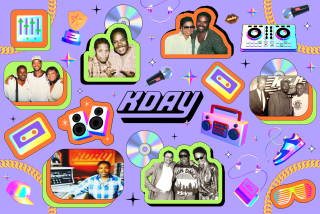O’Reilly Tries Reverse Migration
It’s a migration that has occurred since the earliest days of television--Jack Benny, Arthur Godfrey, Edward R. Murrow, Larry King, Howard Stern--radio stars taking their talents to the newer medium. But Fox News Channel’s pugnacious Bill O’Reilly is headed in the opposite direction, announcing this week that he’s expanding his “no-spin zone” from cable TV to the world of talk radio. Starting May 8, he’ll broadcast for two hours weekday mornings on KABC-AM (790), in direct competition with conservative talk icon Rush Limbaugh.
“He could be doing a lot of other things than spending two hours on the radio,” in addition to the several more hours of preparation required for the job, said Michael Harrison, publisher of Talkers magazine, a trade journal of talk radio. He called O’Reilly’s move “a shot in the arm” for the industry. “Radio has long been a second-class citizen to television. Radio personalities have long dreamed of going to TV,” Harrison said.
But it’s not like O’Reilly is slumming.
“The O’Reilly Factor,” his program on Fox News Channel, draws about 1.5 million viewers nightly--an impressive audience for cable television. On the other hand, Rush Limbaugh’s radio program draws about 20 million listeners per week. “If Bill O’Reilly gets rolled out on 150 to 200 radio stations, he’s going to have far more listeners [than his TV show reaches]. It’s a hell of a promotion for Fox Television,” said Walter Sabo, a New York-based consultant and a former vice president at NBC and ABC radio.
It’s a phenomenon that may happen more often, according to Christopher H. Sterling, director of the graduate telecommunication program at George Washington University, in Washington, D.C., and editor of the Encyclopedia of Radio. With fewer companies owning more and more radio stations, the focus is increasingly on the bottom line, he said. Programmers and distributors recognize that it’s faster and cheaper to hire someone already famous elsewhere, than to try to nurture another Rush Limbaugh, who started as a disc jockey at age 16, and spent five years as a local talk host before going national.
Even though they’ll be airing at the same time in Los Angeles, and seem to have the same conservative-leaning audience, Harrison doesn’t believe O’Reilly presents “a threat to Limbaugh. There are plenty of listeners for both. What O’Reilly presents a threat to are local and other syndicated hosts.”
At KABC, he’s displacing Gloria Allred and Mark Taylor, for instance, while at New York’s WOR, his show is going to push aside talk-radio veteran Bob Grant.
But for Westwood One, which is syndicating O’Reilly’s show, the decision was pragmatic. “You don’t get to launch a radio show with a guy who is the hottest property on cable TV,” said Joel Hollander, president and chief executive of Westwood One. “Something weird has got to happen for this not to be a success.
“It’s obviously great for Bill,” Hollander added. “He’s going to sell a lot more books. The cross-promotion for Fox is tremendous. [Fox News President] Roger Ailes is very happy about that.”
That the O’Reilly-radio match made sense is in part due to a changing radio industry that is becoming less local and more national. “What’s the fastest way to build a national reputation in media? It’s television,” Sterling said.
O’Reilly, who portrays himself as a Joe Sixpack who made good, and who revels in skewering the Clintons or Jesse Jackson, is the second Fox News Channel host to launch a national radio show. Sean Hannity, of “Hannity & Colmes,” went into syndication six months ago with a talk show that originated at WABC in New York, and is heard locally on KABC from noon to 3 p.m.. But Hannity has always worked in radio.
*
O’Reilly dabbled in the medium, including filling in for Paul Harvey when the host was out sick last year. But he drew his fame from television, working as a correspondent for CBS and ABC news. He was host of the syndicated tabloid-TV show “Inside Edition” for six years before his Fox News Channel program debuted in 1996. He has since translated that celebrity into book sales, with “The O’Reilly Factor: The Good, the Bad & the Completely Ridiculous in American Life” selling a million copies and spending 14 weeks atop the New York Times’ bestseller list. Mel Gibson wants to turn his first fiction book, “Those Who Trespass: A Novel of Murder and Television,” into a movie. Still Sterling sees a relatively easy transition for O’Reilly given that talk TV--especially the rehashing of political and social issues that O’Reilly does nightly on Fox--isn’t that different from talk radio. “There’s nothing to look at,” Sterling said of talk TV. “It’s talking heads.”
But by cashing in on personalities already famous elsewhere, talk radio may be eating its young. “There are very few stations out there who can take a chance on young talent,” said Hannity in an interview shortly after his radio show went national.
Describing his 14-year ascension from a Santa Barbara college station to a program syndicated across the country, he wondered how the next generation will work its way up.
“Because there’s so much good syndicated product that’s out there,” the market is harder for aspiring radio hosts to break into, he said.
Consultant Sabo disagreed, noting that in 1982, the U.S. had 59 talk-radio stations. That jumped to 200 by 1988--the year Rush Limbaugh went national--and 600 in 1995. Now it’s about 1,000. “The reason for that is syndication,” Sabo said. Small stations can’t afford to hire enough hosts to fill 24 hours, but they can afford one or two, and fill the rest of the time with national programs. Still, “that’s 1,000 more hosts than there were 10 years ago.”
Meanwhile, Erik Braverman, program director at KABC, said the station plans to keep Allred and Taylor. “It’s our goal to add talent to our roster, not subtract it,” he said, noting that O’Reilly fits the station’s plan to “add the biggest and brightest talk talent available. He has tremendous superstar potential.”
More to Read
The biggest entertainment stories
Get our big stories about Hollywood, film, television, music, arts, culture and more right in your inbox as soon as they publish.
You may occasionally receive promotional content from the Los Angeles Times.










